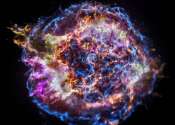Image: The sun in 2020
These 366 images of the sun were made by ESA's Proba-2 satellite in 2020.

These 366 images of the sun were made by ESA's Proba-2 satellite in 2020.
Space Exploration
Jan 7, 2021
0
14

In a study spanning four decades, researchers from the University of Hong Kong's Research Division for Ecology & Biodiversity (HKU) in the Faculty of Science, and Toho University's Department of Biology (Toho), Japan, have ...
Plants & Animals
Jan 7, 2021
0
15

There is no overestimating the importance of pollinators in our world today. While crop pollination relies mainly on managed colonies of the domesticated honey bee (Apis mellifera), wild, unmanaged pollinators were found ...
Plants & Animals
Jan 7, 2021
0
583

Our galaxy hosts supernovae explosions a few times every century, and yet it's been hundreds of years since the last observable one. New research explains why: It's a combination of dust, distance and dumb luck.
Astronomy
Jan 7, 2021
6
94

By comparing thousands of bacterial genomes, scientists in Gothenburg, Sweden have traced back the evolutionary history of antibiotic resistance genes. In almost all cases where an origin could be determined, the gene started ...
Cell & Microbiology
Jan 7, 2021
0
83

It is during rare merging events that galaxies undergo dramatic changes in their appearance and in their stellar content. These systems are excellent laboratories to trace the formation of star clusters under extreme physical ...
Astronomy
Jan 7, 2021
1
1080

The invention of optical fibers has revolutionized not only telecommunications but also sensing technology. Optical fiber sensors can measure strain, temperature, pressure, and many other physical parameters along the fibers, ...
Optics & Photonics
Jan 7, 2021
0
7

Humans feeding leftover lean meat to wolves during harsh winters may have had a role in the early domestication of dogs, towards the end of the last ice age (14,000 to 29,000 years ago), according to a study published in ...
Archaeology
Jan 7, 2021
0
517

The battle to survive is fought down to the level of our genes. Toxin-antidote elements are gene pairs that spread in populations by killing non-carriers. Now, research by the Burga lab at IMBA and the Kruglyak lab at the ...
Cell & Microbiology
Jan 7, 2021
0
29

El Niño events have long been perceived as a driver for low rainfall in the winter and spring in Hawai'i, creating a six-month wet-season drought. However, a recent study by researchers in the University of Hawai'i at Mānoa ...
Earth Sciences
Jan 7, 2021
0
14